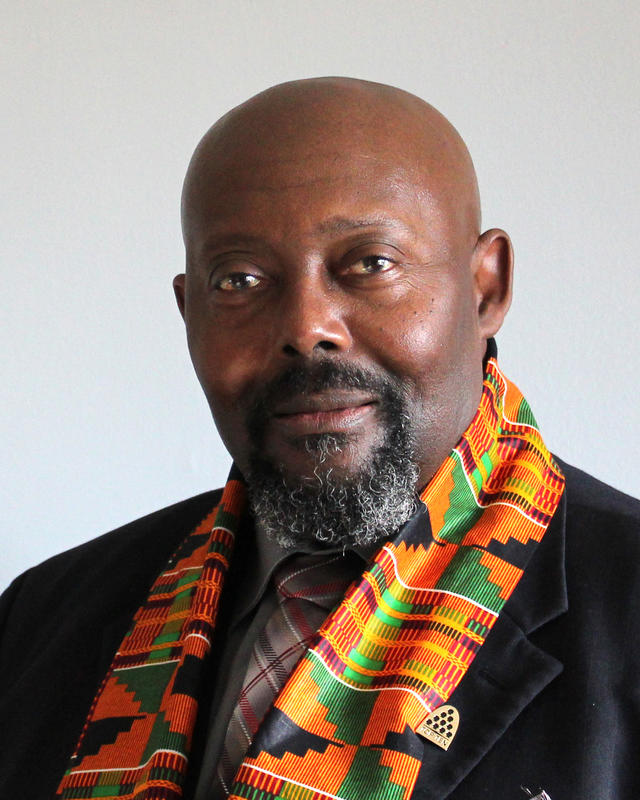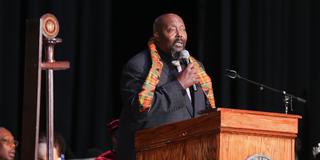
Longtime Central State University arts professor is optimistic about growing program

Above: Dwayne Daniel speaks during the 136th Charter Day Convocation in 2023.
One aspect of Dwayne Daniel that immediately shines through upon speaking with him is his staunch belief that the creative act is a means for vibrant community service.
“Most of my personal and professional growth has been the result of my attempts to provide services,” said Daniel, a longtime professor of Studio Art in Central State University’s College of Humanities, Arts, and Social Sciences. “Public service is second nature for me. I strongly believe that most of the good in the world is the result of people providing services simply because the services are needed.”
Both a self-expressive fine artist and commercially savvy graphic designer, the Dayton-based Daniel hails from Eastman, Georgia, where he lived until he turned 11 years-old in 1973. It was then that Daniel’s family moved to his adoptive home, which gave him “a unique perspective on the many influences that affect who he has become and how he sees the world.”

With a focus on what was, at the time, referred to as “advertising graphics” and studio arts, Daniel graduated with honors from Central State in 1986. He then concentrated on graphic design and illustration while receiving his Master of Fine Arts from Oxford, Ohio’s Miami University in 1988. Later returning to his alma mater as an instructor, Daniel would become the first full professor in the history of its illustrious visual arts program.
Other accomplishments during Daniel’s three decades as a CHAS faculty member include volunteering for nine years as coordinator of the visual arts component of the Central State University Center of Excellence, as declared by the Ohio Board of Regents in 2011. Under his stewardship of the program and primary writer of the 2017 National Association of Schools of Art and Design (NASAD) self-study document, the NASAD Commission voted to grant full membership and accreditation to Central State.
“I knew that was going to be an artist at a very young age — something that I declared out of ignorance,” laughed Daniel during a recent phone interview. “I was about 6-years-old, and people kept telling me that’s what I was when I was in school: an artist."
“People would be looking at me drawing, and they thought it was like magic,” Daniel continued. “I didn’t think of it like that, because I thought that everybody could do it; everybody could draw.”
One of the reasons Daniel was so confused was that his older brother could “always draw stuff, too, and I wanted to compete with him. You know that sibling rivalry. Especially when it’s with an older sibling. They have a unique way of helping to mold you. And that’s one of the things my older brother would do. He’d tell me everything I was doing wrong, which kept me fired up and heated.”
This fiery motivation and creative critiquing coming from his older brother combined with Daniel’s innate talents and preternatural understanding of such complex concepts as perspective drawing. Daniel claims he understood this sophisticated form of drawing as well as a third-grader as he does now.
“I definitely wouldn’t have had the words for that at the time, but it was a matter of trying to figure out how things worked,” Daniel said. “I would be thinking about how I wanted something to look, and then I would have an epiphany about how to advance in a way that would make it work. It was therefore more of an analytical discovery than any type of ‘expression.’”
When he began attending Miami University, Daniel made his way into arts education. His professors had been looking at his portfolio and were impressed enough that they assigned him classes to teach. This came as something of an unwelcome shock to the humble, slightly introverted, young Daniel.
“I’d heard of assistantships before, but I’d never heard before about somebody just being thrown in front of a class by themselves,” Daniel said. “I was 23 at the time and had no interest whatsoever in teaching. Full disclosure: that was one of the most terrifying things I had ever gone through! I almost left and went home.”
Daniel revealed that a major factor in his not fleeing his teaching charge was the fact that, as a first-generation college student, he felt it was his duty — for the posterity of his family who had been supporting and encouraging him to gain his education — to stay.
Interested or not, terrified or not, Daniel ended up teaching arts fundamentals and a class on drawing throughout his graduate school tenure. He additionally taught architect hopefuls perspective drawing.
“Over the course of my teaching,” Daniel said, “I gradually gained the confidence that my foundations coming out of what I learned at Central State allowed me to be more solid than most of the individuals I was dealing with at Miami University.”
It was at that time that Daniel realized, “This was something that I could do. I could teach. Prior to that, I just saw myself as a graphic designer, ‘slash,’ illustrator.”
After his revelatory experience at Miami University, Daniel went on to teach figure drawing and similar courses on the East Coast, not believing that he would return to Ohio as his home base. When both his mother and father fell ill in 1990, he returned to Dayton, where he worked as an adjunct professor at Sinclair College and Central State.
“I had always been working closely with and remained friendly with Willis ‘Bing’ Davis,” Daniel said.
“Actually, I was among his first recruits as a student into the visual arts program that he had been brought on to revitalize, rebuild, and redesign at Central State. Bing was, more than anything, the reason I ended up there to begin with. Then, these years later, he once again recruited me, this time to apply to and teach at Central State.”
Over the years that Daniel has taught at Central State, he has seen challenges as well as triumphs, but in the end refers to the program as “resilient.”
“And that’s one of the reasons that we initiated the process for being accredited by NASAD: because I knew that we had something to offer,” he said. “As an academic experience for underprivileged citizens from underserviced communities, Central State has always made itself available. Central State has always done that, and that’s made a difference. Based on my experience, I am extremely optimistic of this program and this Institution, especially when it comes to the growth and improvement I’ve seen over the years.”


